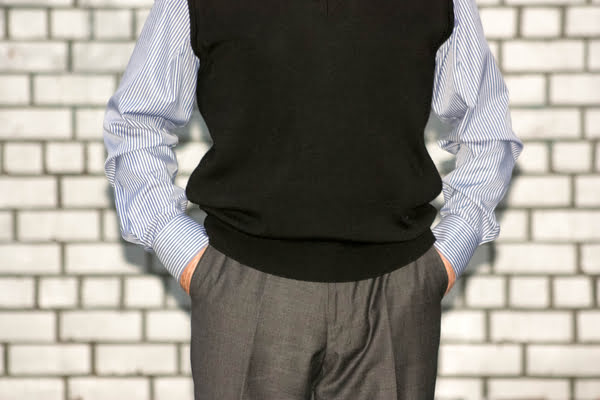Keeping your hands in your pockets is one of those body language gestures that can have multiple, seemingly contradictory meanings. In body language, the meaning of some gestures is straightforward. You only need to observe one or two gestures to reach a conclusion.
In other cases, such as the ‘hands in pockets’ gesture, you need to look at the context of the situation and accompanying gestures (gesture cluster) to reach a sound conclusion.

In this article, I’ll discuss what the ‘hands in pockets’ gesture and its variations mean. I’ll also give reasons behind the various meanings.
Hands in pockets meaning
First, we’ll eliminate the non-psychological reasons why people put their hands in their pockets. For example, feeling cold or checking your keys. Another example would be a situation where you have nothing better to do with your hands like when you’re waiting for someone.
We’re not concerned with these but you should keep them in mind.
Now, let’s look at the psychology of putting your hands in your pockets.
With body language gestures that are vague, ambiguous, and hard to interpret, it’s best to look at the opposite gesture. The meaning opposite to the meaning of the opposite gesture would be the meaning of the vague gesture.
So, to understand the mental state of a person with their hands in their pockets, ask yourself:
“What does it mean when someone doesn’t have their hands in their pockets?”
When you talk to someone who doesn’t have their hands in their pockets, they come across as open, trustworthy, and secure.
Showing your hands and moving your arms freely in social interactions signals openness and confidence in expressing yourself with your body.
Body language doesn’t lie. People who are open and confident naturally talk with their hands and bodies.
Not showing your hands by keeping them in your pockets sends the opposite signal. It indicates defensiveness and insecurity. It’s a ‘closed’ body language gesture. When you assume this gesture, you’re closing others off. You’re hiding yourself from others.
Retreating your hands in your pockets in a social context communicates:
“I don’t want to engage with you.”
Social anxiety
Social anxiety is probably the number one reason why someone would close themselves off from others.
If you’re socially anxious, you may have noticed that you hardly keep your hands in your pockets in a non-threatening situation (like your home). But when you go out, social anxiety kicks in, and you frequently find yourself with your hands in your pockets.
Having hands in pockets signals discomfort, and people can sense it, even if they can’t put a finger on it. When they interact with you, they’ll sense something is off.
To test this, see what happens the next time you’re having an open, friendly conversation with someone and suddenly put your hands in your pockets. Most likely, the conversation will die down.
Your closing off may trigger their closing off. They may put their hands in their pockets too, or only retreat from the conversation mentally.
An attempt to comfort
In body language, there’s a class of gestures called self-soothing gestures. When we’re anxious and nervous, we need to soothe ourselves physically. One way of doing it is by touching your face. Another is wringing your hands.
When you feel insecure and uncomfortable in a social situation, putting your hands in your pockets provides a sense of security and comfort, like retreating into a cave.
It communicates:
“I’m comfortable and relaxed.”
Some people observing you may buy into this and not realize that your comfort stems from discomfort.
Disengagement and disinterest
When we don’t want to engage, we’re usually not interested.
This lack of interest in engaging may stem from social anxiety, but it may also stem from confidence and arrogance.
If you think you’re better than those around you, you may cut them off and disengage by putting your hands in your pockets. It signals:
“I’m too good to engage with you.”
This is why people trying to look cool also assume this gesture. When you see someone posing for a photograph with their hands in their pockets, they’re communicating:
“I’m uninterested in you.”
“Whatever.”
“I’m only concerned with myself and how I look because I’m cool.”
When you see fans taking autographs from celebrities, who engages with whom and to what degree?
Of course, the fans engage more with the celebrity because they’re interested in the latter more than the latter is interested in the former. While the fans jump with joy, push themselves through the crowd, and wave many times at the celebrity, the latter just signs their pad and waves back maybe once or twice.
Imagine a fan approaching a celebrity with their hands in their pockets. Watching this, you may mistake the fan for some celebrity or authority figure. The fan reduces the power gap between a fan and a celebrity by lowering engagement. With hands in pockets, the fan communicates indifference.
I don’t know about you but we got scolded a lot in school if we talked to teachers (authority figures) with hands in our pockets.
If you care about the people around you and want to engage with them more, you can make much progress by simply taking your hands out of your pockets. As this short film demonstrates:
Variations and accompanying gestures
If you see someone with their hands in their pockets and are unsure about the meaning, look at the context, accompanying gestures, and variations of the gesture.
A common variation of the hands-in-pockets gesture is putting your thumbs in your pockets with your fingers out. This crotch display is usually assumed by men in the presence of women or other men they’re trying to threaten.

If a person has their fingers in their pockets with thumbs sticking out, it’s a gesture that signals high confidence. The thumb is the most powerful digit of the hand, and the thumb displays signal power.

Walking with hands in your pockets makes you look smaller. In body language, you make yourself physically smaller when you feel smaller.
A person who feels small, unconfident and insecure may also put their head down and have their shoulders hunched.
Keeping your hands in your pockets with relaxed shoulders and an upright chin amplifies the “I’m cool” signal.
When walking with hands in pockets, walking speed plays a key role. When walking speed is low, a person is probably relaxed. Think of walking slowly on a beach.
When walking speed is high, the person subconsciously tries to escape the situation because they feel uncomfortable.
Having one hand in the pocket is a partial attempt at disengagement. The person may be feeling partially uncomfortable. They may vacillate between wanting to connect (because they’re interested) and holding back (because they’re uncomfortable or want to look cool or both).
Walking with one hand in a pocket is a very dominant gesture. The person has freed one hand to engage while also retaining disengagement. The gesture signals:
“I want to engage but on my terms.”
“I run this place, and I’m not listening to you.”
